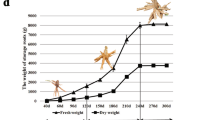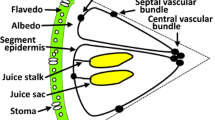Abstract
As an approach to increased production of rape seed oil from Brassica napus L., Arabidopsis thaliana, a species from the same Brassicaceae family, was used to investigate transport behavior and distribution of matter in the plant body. In this study, sucrose, an initial metabolic product of photosynthesis, labeled with carbon-14 was used. The sucrose was applied to A. thaliana via the surface of a rosette leaf. Using the real time radioisotope imaging system we developed and an imaging plate (IP), images of whole or part of the sample were obtained. The sucrose assimilation products were accumulated in maturing tissue such as flowers and fruits, and in a joint part. From the comparison among branches and stems, it was indicated that there were different patterns of demand and distribution of sucrose assimilation products depending on the tissue and its growing stage. This might be caused by either morphological reason such as diameter and location of the sieve tube, or genetic factors such as an activity of a membrane transport protein. Because of self-absorption of carpels, it was difficult to observe the accumulation of carbon-14 in the seeds inside the fruits; however, an IP image of a frozen section of a fruit revealed that carbon-14 transport to seeds was higher than that of carpels. These methods will help us gain insight into matter transport and strategies to improve the production of rape seed oil.
Similar content being viewed by others
Avoid common mistakes on your manuscript.
Introduction
Yield improvement is one of the main purposes of botanical research. The information about uptake and distribution of water, nutrients, photosynthesis products, etc., is important not only as primary information about plant physiology, but is also closely related to strategies for nutrient or matter transport and accumulation in the certain parts of the plant body, usually fruit. A number of studies have mentioned transport speed and amount of specific matter. For example, Sheoran et al. [1] reported that for Brassica campestris L., translocation of fixed carbon from the pod wall to seeds was rapid, and pod photosynthesis contributed substantially to seed growth. In these researches, radioisotope (RI) imaging is a useful tool. In our laboratory, we have been developing a real time RI imaging system (RRIS), which enables us to follow the transportation of nuclides in a living plant [2, 3]. We have applied phosphate-32, for example, to sample plants and obtained successive images, but little investigation was performed for low energy β emitters such as carbon-14. Indeed, RRIS images of sucrose or CO2 labeled with carbon-14 in the living plant would provide significant information. We therefore investigated translocation of sucrose, an initial product of photosynthesis, in a plant body, using carbon-14 labeling.
This paper is the initial part of a study that aims to improve the yield of oil produced by rapeseed, one of the major oilseed crops. It is difficult to investigate the whole plant body because of its large mass and long life cycle. Therefore, in this research, Arabidopsis thaliana, which is in the same Brassicaceae family as a rapeseed plant, but with a smaller plant body and shorter life cycle, was used to investigate transport behavior and distribution of photosynthetic metabolites in plant tissue.
Experimental
Plant preparation
Seeds of A. thaliana were germinated on the block of a glass-wool. After 7 days, the seedlings were transferred to a nutrient solution (MGRL) [4] in the growth chamber (16 h light/8 h dark condition at 22 °C with 60 % of humidity), then cultured for 2–8 weeks.
Frozen section preparation
10 μm thick frozen sections from A. thaliana fruits were prepared using a multi-purpose cryosection preparation kit (LEICA MICROSYSYSTEMS, Co.) and analyzed with an imaging plate [5].
Foliar absorption of 1-carbon-14 labeled sucrose
MGRL solution (500 μl) that contained 0.1 % of Triton x and 1 % of agar was held in a 4.5 × 2 cm size of polyethylene bag. A rosette leaf was put in the bag, and then 1.85 M Bq/500 μl of carbon-14 labeled sucrose were poured to the bag. The mouth of the bag was sealed with a double-stick tape. During the foliar absorption treatment, the samples were placed into the growth chamber or dark box with conditions similar to those of normal culture.
Imaging plate (IP) analysis
The samples were fixed on the paper and covered with polyethylene film for prevention of contamination. After 5–20 h of exposure of the sample to an IP (FUJIFILM, Co.), the IP was scanned by a scanner (FLA-5000, FUJIFILM, Co.) where the resolution was set at 100–10 μm. Because each branch was sprouted in different directions, which disrupted equivalent contact to the imaging plate, the branches and cauline leaves of the plant were separated from the stem.
Analysis of RRIS
Successive images of carbon-14 uptake in the plant were taken using the system we developed. The schema of the system is shown in Fig. 1. Above-ground part of the sample were fixed on the CsI scintillator deposited on the fiber optic plate and the non-RI culture solution was supplied from the roots to maintain the sample in a living condition. The image was integrated for 15 min and obtained once per hour. During 45 min of non-integration time, the plant was intermittently irradiated with light from LEDs (7.94–10.58 μmol S−1 m−2) fixed in the dark box. 20–90 images were obtained successively. Images obtained from both the IP and RRIS were analyzed with ImageGauge software (FUJIFILM, Co.).
Results and discussion
Images of whole and part of A. thaliana
Images obtained from RRIS for a 30-day-old plant under dark conditions are shown in Fig. 2a. High accumulation of carbon-14 was obtained for maturing tissue, flowers and fruits, and at the joint of three parts, stem, branch and the cauline leaf (Fig. 2b). This suggested that either requirement from developing tissue or morphological factors caused accumulations of carbon-14.
Each flower of A. thaliana produced a fruit about 2 days after flowering. IP images of fruits showed two kinds of images, depending on the day after flowering (i.e. the degree of maturation—Fig. 2c). The young (about 2 or 3 days after flowering) fruit showed uniform accumulation of carbon-14 in the longitudinal direction. In contrast, mature fruits (over a week after flowering) showed an accumulation at the tip.
One must consider the effect of self-absorption and note the signal intensity of images might not always reflect the accumulation of the nuclide in the plant body when we use a low energy β emitter such as carbon-14. Therefore, IP analysis of frozen sections was used to observe the inside of the fruits. For the fruit harvested 7 days after flowering, the accumulation of carbon-14 observed was greater in the seeds than in the carpels (Fig. 2d).
As was shown for phosphate [6], our results indicated that there was a different demand on sucrose assimilation products among the tissues, and that movement differed either among tissues or developmental stages. It was difficult to observe the transport behavior of carbon-14 to seeds in the living state; however, section analysis using an IP for several fruits in different maturing stages was expected to provide the information about the maturation process.
Comparison between branches
To investigate the distribution of carbon-14 among a stem, primary, and secondary branches, a 60-day-old plant, which had several branches, was selected for IP analysis (Fig. 3). In four primary cauline leaves, as well as in branches, there was a difference in accumulation of carbon-14. There was a tendency for branches that had cauline leaves with a high accumulation of carbon-14 to also show high accumulations of the isotope. However, it is interesting that, although the accumulations of carbon-14 in some primary cauline leaves were low, some secondary cauline leaves of the branch showed high accumulation of carbon-14. This suggested that there is an order of carbon-14 flow from primary branches to secondary branches that is separate from that of stems and primary branches. The difference in transport of carbon-14 among the branches might be caused by either morphological factors such as the diameter and location of sieve tubes, or genetic factors such as the activity of a membrane transport protein [6].
Comparison between young and old stems
The RRIS images of shoot apices that are expected to require higher sucrose were obtained for four stems from the same plant at different growing stages (Fig. 4). The youngest stem accumulated carbon-14 in the top 3–5 cm and in young fruits. In contrast, a uniform accumulation of carbon-14 was observed for the older stem. The oldest stem showed no activity on RRIS- the image obtained from IP showed uniform and low accumulation of carbon-14 (data not shown).
The result showed that the sucrose absorption and transportation behavior of A. thaliana were differed depending on its parts and growth stages. The relationships between the signal of cauline leaves and branches were one of the interesting results. However, quantitative discussion was difficult so far, because of characteristics of carbon-14. In further studies, an improvement of RRIS and use of liquid scintillation counter will enable us to determine quantities of carbon-14 assimilation products. Then we will try to investigate which part shows the highest degree of contribution for photosynthesis in each growth stage, and make an appropriate cultivation plan to obtain increasing production of rape seed oil.
Conclusions
To investigate the transport and distribution of sucrose, an initial metabolic product of photosynthesis, sucrose labeled with carbon-14 was applied to A. thaliana. Images of carbon-14 in the plant body were obtained using the RRIS and an IP. The sucrose assimilation products were accumulated in maturing tissue and in joint parts. From the comparison among branches and stems, there seemed to be different demand and distribution of sucrose assimilation products not only among tissues but also among growing stages. Because of self-absorption, images of seeds inside the fruit were not obtained from RRIS; however, IP analysis of frozen sections gave information about the accumulation of carbon-14 in the seeds. The difference in transport of carbon-14 among the tissues might be caused by either morphological or genetic factors. IP analysis of sections of stems and joint parts is expected to be a useful tool.
References
Sheoran IS, Sawhney V, Babbar S, Singh R (1991) Ann Bot 67:425–428
Rai H, Kanno S, Hayashi Y, Ohya T, Nihei N, Nakanishi TM (2008) Radioisotopes 57:287–294
Yamawaki M, Kanno S, Ishibashi H, Noda A, Hirose A, Tanoi K, Nakanishi TM (2009) J Radioanal Nucl Chem 282:275–279
Fujiwara T, Hirai MY, Chino M, Komeda Y, Naito S (1992) Plant Physiol 99:263–268
Kawamoto T (2003) Arch Histol Cytol 66:123–143
Kanno S, Rai H, Ohya T, Hayashi Y, Tanoi K, Nakanishi TM (2007) J Radioanal Nucl Chem 272:565–570
Acknowledgments
This work was supported by the Funding Program for Next Generation World-Leading Researchers (NEXT Program) [GS-007].
Author information
Authors and Affiliations
Corresponding author
Rights and permissions
About this article
Cite this article
Ohmae, Y., Hirose, A., Sugita, R. et al. Carbon-14 labelled sucrose transportation in an Arabidopsis thaliana using an imaging plate and real time imaging system. J Radioanal Nucl Chem 296, 413–416 (2013). https://doi.org/10.1007/s10967-012-2131-1
Received:
Published:
Issue Date:
DOI: https://doi.org/10.1007/s10967-012-2131-1








